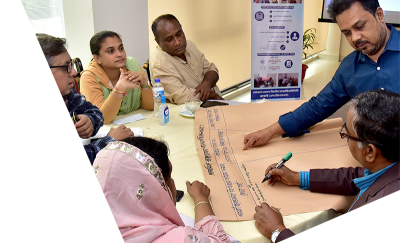How to Make Federal Justice Data More User Friendly


An interview with Chris Cutler
Chris Cutler was born in Foxborough, MA, and lived just 10 minutes from Gillette Stadium, where the New England Patriots play. But football wasn’t his focus in middle school and high school. The crime show CSI was. That sparked an interest initially in forensic science and then data science, where he has made his mark in his work at Abt for the Bureau of Justice Statistics (BJS) on the Federal Justice Statistics Program (FJSP). A graduate of the University of Miami with a master’s in criminal justice from State University of New York, Albany, he likes managing large data sets and investigating data issues to make a more harmonious final product for end users. Data quality has always been his primary focus and where he gets the most joy from his work. Chris sat down with us to discuss what he’s been doing and his plans for the future.
Q: Tell us about your background, how you got into what you're doing.
A: I began college as a biology major with a goal of becoming a forensic scientist. My career trajectory changed during my junior year after an in-lab internship on a cancer study at the University of Miami Medical School. One of my primary tasks was to count the number of cells that had migrated from one side of the membrane to another every two hours. I ended up counting hundreds of cells each week, often with little tangible data to show for my efforts. At the end of that semester, I thought, “this is awful” and realized that a career working with a microscope wasn’t for me. At the same time, I began taking more criminal justice classes to broaden my skillset and eventually completed a second major in criminal justice.
Then I was accepted into a criminal justice Ph.D. program at SUNY Albany. While working on a research project with Dr. Shawn Bushway, I had my first opportunity to write a statistical program. It's funny to look back at my trajectory, because growing up, I loved math but was not a big computer person. My typing was, and still is, hunt-and-peck. The fact that all my work is on a computer and it's coding-based is funny to me.
I've always been a detail-oriented person, which sometimes leads me to miss the forest while examining the trees. Tracking down that 1 percent of cases that no one cares about because they don’t impact the whole story--that was where I found my niche. I liked trying to understand what was happening and why. What was different about these cases? What could we learn to improve the product?
I quickly realized that a Ph.D. was not a great fit for me. I left after I got my master's and returned home to Boston. A couple of months later, I got a job at Abt, in April of 2014. I've been working on our criminal justice project for more than 10 years. It's just crazy to think about.
Q: Can you explain the Federal Justice Statistics Program FJSP?
A: The FJSP collects and standardizes administrative data on individuals involved in the federal justice system and has been operated by the Bureau of Justice Statistics (BJS) since the 1980s. On this project, we collect data from federal agencies spanning arrest and booking (U.S. Marshals Service), investigation (Executive Office for U.S. Attorneys), court proceedings (Administrative Office of the U.S. Courts), sentencing (United States Sentencing Commission), and incarceration (Federal Bureau of Prisons). New data are processed each year and standardized to align information across years and agencies.
There are two primary strengths of the FJSP data collection: the longevity of the series and the dyad link files, which connect individuals in adjacent agencies. Presently, the FJSP spans nearly 30 years (fiscal years 1994 – 2022). Deidentified versions of these data are available for researcher use with an approved Institutional Review Board package through the National Archive of Criminal Justice Data (NACJD). A limited set of variables for fiscal years 1998 – 2022 are available for querying through the project’s public web tool, the Federal Criminal Case Processing Statistics (FCCPS). Individuals interested in more information on the project or the data available should go to the BJS website or NACJD.
The dyad link files connect individuals in adjacent stages using common person and case level identifiers. The capability allows users to follow cohorts of individuals from arrest and booking through incarceration, which expands the types of research questions that can be investigated.
Abt has been the contractor on this award since 2013, but we haven’t rested on our laurels. We are perpetually looking for ways to improve the quality, timeliness, and breadth of the data collection. When we received data for the first time from the Executive Office for Immigration Review (EOIR) for individuals in immigration courts, I led the development of processing programs to create annual data files from the raw agency data. After months of painstaking work, we presented our standardization approach to the agency. During this meeting, representatives from EOIR indicated that our efforts were the closest that any external group had come to replicating their published statistics.
FJSP has been an underutilized resource for the criminal justice research community. We're always looking for ways to excite the next user who's going to find a dissertation topic or the next paper idea from the FJSP.
Q: Can you explain the difference between the old tool for using data and the upgrade?
A: The FJSP web query tool is called the Federal Criminal Case Processing Statistics (FCCPS) Data Tool (ojp.gov). It's been around for at least a decade now, and the previous iteration was coming to the end of its life span. The BJS was no longer supporting the technology it was originally built on. The previous version of the FCCPS was good at producing tables but wasn’t super modern in its utility and offered users limited flexibility.
In November 2023, the FCCPS was transitioned to a Tableau-based platform. We've added a lot of flexibility to enhance the user experience, including increased filtering capabilities and multiple data visualization options (such as bar graphs, line graphs, and heat maps to show the interaction of two different variables). In the original tool, users could select one or two variables to display in a table and filter one additional variable. Each selection was a separate step. That limited how deeply you could dig into the data. With the updated tool, researchers can filter multiple variables at the same time. It gives users a lot more flexibility to really dig down into the weeds in the data to look at the populations that they're interested in. Abt will continue work on this tool as part of a new award with BJS to expand its capabilities for users.
Q: Can you provide more detail about the data users can get?
A: We have two main components to the tool. The first one, accessible by the links under the By Stage header on the FCCPS home page, enables users to query statistics and generate graphics for nine cohorts spanning law enforcement, prosecution/courts, and incarceration. The law enforcement stage includes data from the U.S. Marshals Service about individuals arrested and booked as well as from the Executive Office for U.S. Attorneys about investigations initiated and concluded. The prosecution/courts stage covers individuals charged in criminal cases and cases that are closed and uses data from the Administrative Office of the U.S. Courts as well as information from the U.S. Sentencing Commission about individuals who are sentenced, not necessarily to prison. The incarceration stage consists of information about individuals entering prison, those who are in prison at the end of the year, and those who are released from the Federal Bureau of Prisons.

The second component of the tool, accessible by the links under the By Title and Section header on the FCCPS home page of the “United States Code Statistics” button at the top of the page, enables users to query statistics by U.S. criminal code title and section. It's an expansion of the prosecution data and enables users to dive into specific criminal codes of interest. Let's say you were interested in looking at trends in human trafficking prosecution. Under the United States Code citation dropdown, you could select the specific citations of interest (i.e., 18:1581 – 18:1594 C) to generate a table with the number of persons in cases filed where their lead charge was a human trafficking statute.
Q: How might reporters find this useful?
A: For stories related to the workload of the federal justice system or trends in the population/characteristics of cases being handled, the Law Enforcement, Prosecution/Courts, and Incarceration tabs would enable reporters to explore trends for nearly 25 years of data. The tool enables users to export the data tables or graphics generated.
If a reporter is interested in a specific offense or statute, the United States Code Statistics tab enables users to explore trends in enforcement for specific criminal codes. In this component of the tool, users can look at trends in cases filed or terminated, as well as outcomes and sentence type for persons convicted. Users can even compute the mean prison sentence, probation sentence, and fine by year for statutes of interest. For stories on specific offense types, this component of the tool is invaluable.
Q: What do you think is the most exciting thing about the new developments?
A: The most exciting part to me is that this is just the tip of the iceberg. We introduced a lot of new visualizations and new filtering capabilities, which expand the types of queries possible with the tool. In the previous iteration of the FCCPS, user’s ability to look for specific groups or really dig down into the data was limited based on the number of variables that you could filter on. The expanded filtering capabilities really opens up additional avenues for exploration. The additional visualizations make the tool more accessible to certain users who might have difficulty discerning trends from tabular data. Many people are very visual learners and so being able to see line trends over time, being able to see bar graphs and other ways of representing the data besides in tabular form really expands the audience that could find this tool useful.
Q: Any closing thoughts?
A: We're always looking for new ways to expand the utility of the tool. As part of our new work with BJS, we know there is more to offer users. Going forward, we plan to incorporate new data, new visualizations, and new features into the FCCPS. We're excited to share the latest capabilities of the tool and look forward sharingwhat’s on the horizon.
Read More

Human Trafficking Prevalence Estimation Feasibility Study
Abt developed a feasibility study to determine how the U.S. could pilot important data collection to assess national estimates of human trafficking.

USAID Catalytic Action through Localized Policy Solutions (CATALYST)
USAID CATALYST is a global program that helps countries build policy and institutional frameworks that enable greater investment in sustainability and resilience across sectors.

Health Systems Research (HSR) 2024
Abt Global is exhibiting and presenting at Health Systems Research (HSR) in Nagasaki, Japan in November 2024.

Spotlight On: Climate Finance
Abt Global can help public-and private-sector actors take decisive action to finance climate mitigation and adaptation strategies.

Abt Leads Decision Support for FCDO Land Governance Programme
Abt Global Britain has been appointed to lead the Decision Support Unit of the Land Facility, funded by the UK’s Foreign and Commonwealth Development Office.

Fighting on Their Front: Ukraine’s Women Entrepreneurs Are Fueling a Wartime Economy
How investing in growth for all pays dividends in Ukraine.

2024 Academic Consortium on Criminal Justice Health (ACCJH)
Join Abt experts in Phoenix for ACCJH 2024, The Academic Consortium on Criminal Justice Health.

Migrants in Colombia Find Kindness and Support in ‘Alliances of Solidarity’
USAID’s Abt-led Local Health System Sustainability (LHSS) project built a Colombian non-governmental organization (NGO)’s capacity to help migrants get health care.

2024 Society of Toxicology (SOT) Annual Meeting
Abt is a proud sponsor of the 2024 Society of Toxicology Annual Meeting.

The Future of Health Systems: Investing in Primary Health Care Workers - A Call to Action
On February 29, 2024, join us for an insightful discussion about how frontline health workers are critical to health systems.

Mining Royalties Fueling Improved Health Coverage in DRC
Abt's work in the Democratic Republic of the Congo (DRC) is laying the groundwork for local governments to ramp up decisionmaking and spending on health priorities.

Spotlight On: Advancing Fiscal Transparency & Improving Service Delivery Through PFM Support
Abt helps governments around the world enable sustainable economic growth, advance fiscal transparency and accountability, and improve service delivery.

What Does the U.S. Spend on Law Enforcement? JEET Has Answers
A new Abt-developed webtool supports analysis of criminal justice expenditures and employment.

Spotlight On: Community Supervision
At Abt Global, we study some of the most difficult public safety and justice issues facing the nation and offer practical solutions to policymakers, practitioners and funders.

Spotlight On: Adaptive Management
Abt-led programs use adaptive management processes such as rapid cycle learning and strategy testing to promote a learning culture and deliver social impact.